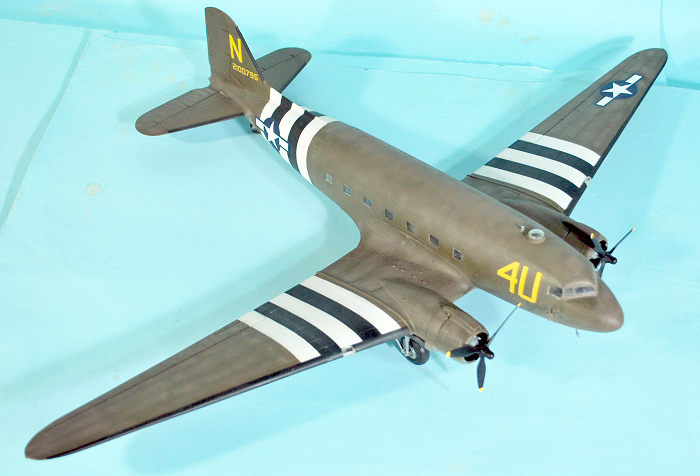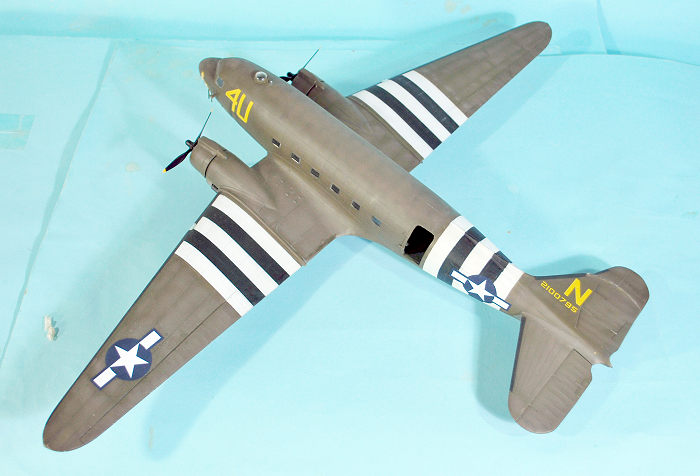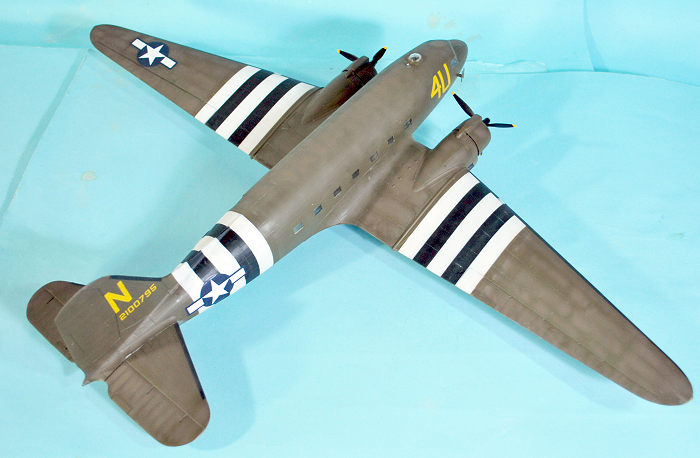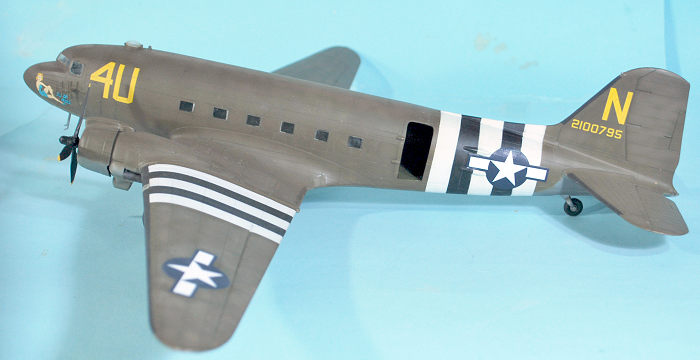
Monogram 1/48 C-47 Skytrain
| KIT #: | 5603 |
| PRICE: | $ |
| DECALS: | Two options |
| REVIEWER: | Tom Cleaver |
| NOTES: | Sagle Strike 48-043 “Skytrains at War” |

| HISTORY |
The C-47 is the military development of the Douglas DC-3, the civil airliner that has been called “The Plane That Changed The World.” That is not hyperbole. The DC-3 was unlike any airplane that came before it. It gave airlines profitability just hauling people. It was amazingly rugged. My father was on a flight from Denver to Phoenix in 1957, through the Rockies, during which the updrafts and downdrafts tossed the DC-3 against the side of a mountain, knocking ten feet off the left wing. The DC-3 flew on successfully to Phoenix.
In 1997, I had the opportunity to experience what the DC-3 meant to air transportation, when I flew in the Planes of Fame Ford Trimotor, and six weeks later flew in one of the restored DC-3s at the airport. The Ford Trimotor rattled and banged and bounced; I could stand in the middle of the aisle in the passenger compartment, stretch my arms and touch the sides of the cabin. The DC-3 was enormous in comparison, with twice the passenger capability. It reeked of “solidity” from the moment I boarded it through the entire flight, which was flown on a “bouncy day” weatherwise. As a friend who had flown in both “back in the day” put it, “The Trimotor was a Model-T; the DC-3 was a Packard Limousine in comparison.”
The C-47:
 General
Dwight Eisenhower said after the war that “four weapons helped most to win the
war — the C-47 Skytrain transport, the Jeep, the bazooka, and the atomic bomb.”
General
Dwight Eisenhower said after the war that “four weapons helped most to win the
war — the C-47 Skytrain transport, the Jeep, the bazooka, and the atomic bomb.”
Douglas Aircraft presented the USAAF with a proposal to modify trheir DC-3 transport for military use in 1940. The specialized C-53 “Skytrooper” was a minimum-change aircraft for tranporting paratroops. It started production in October 1941 at Douglas Aircraft's Santa Monica plant. The C-53 lacked all of the major changes introduced in the C-47. Only 380 aircraft were produced.
The C-47 differed from the civilian DC-3 and the C-53, with many modifications, including a large double wide cargo door large enough to allow a jeep to be loaded aboard, a hoist attachment and a strengthened floor. Externally, it had a shortened tail cone for glider-towing shackles, and an astrodome in the cabin roof.
During World War II, the armed forces of many countries used the C-47 and modified DC-3s for the transport of troops, cargo, and wounded. The U.S. naval designation was R4D. More than 10,000 aircraft were produced in Long Beach and Santa Monica, California, and Oklahoma City, Oklahoma. Between March 1943 and August 1945, the Oklahoma City plant produced 5,354 C-47s.[2][5]
The C-47 was vital to the success of many Allied campaigns. The Guadalcanal campaign would have failed had the island not been re-supplied with fuel, ammunition and food by the Marine R4Ds (Navy designation of the C-47) operating from Espiritu Santo.
C-47s were used to airlift supplies to the encircled American forces during the Battle of Bastogne. They also resupplied the jungle airfields on the Stanley Plateau in New Guinea, allowing the fifth Air Force fighters to operate against Japanese bases on the northern shore of the island and against Rabaul.
 What was
possibly the C-47's most influential role in military aviation was “Flying The
Hump" from India into China. The expertise gained in this operation was later
used in the Berlin Airlift, where C-47s pioneered 24/7 all-weather operations,
which later transformed civilian air transport.
What was
possibly the C-47's most influential role in military aviation was “Flying The
Hump" from India into China. The expertise gained in this operation was later
used in the Berlin Airlift, where C-47s pioneered 24/7 all-weather operations,
which later transformed civilian air transport.
In the European Theater, the C-47 first saw action delivering paratroops in the North African invasion in November 1942. During the invasion of Sicily in July 1943, C-47s dropped 4,381 Allied paratroopers. Over 50,000 American and British paratroops were dropped by C-47s during the invasion of Normandy in June 1944. The last combat use of the aircraft in the ETO was “Operation Varsity,” the airborne assault to lead the crossing of the Rhine River in March 1945.
British Commonwalth air forces used 2,000 C-47s, named “Dakota” for the acronym "DACoTA" for “Douglas Aircraft Company Transport Aircraft.” No one knows exactly how many Li-2's - the Soviet license-built C-47 were produced in the Soviet Union where it was the backbone of Red Army air transport. The airplane served on both sides during the war, with the Imperial Japanese Navy using license-built DC-3s, code named “Tabby” by Allied air intelligence.
In all the years of the C-47's service, it was flown by over 100 air forces around the world. The USAF used the C-47 as a ground support attack aircraft armed with miniguns in the Vietnam War. The USAF 6th Special Operations Squadron flew C-47s until 2008.
In 2023, two original C-47s are still actively flown commercially by Buffalo Airways in Yellowknife, Northwest Territories.
C-47s are on display in museums in over 60 countries. 43-30652, “Whiskey 7," the lead plane in Mission Boston on D-Day, is on display at the National Warplane Museum in Geneseo, New York. There are 20 C-47s that are flyable in US museums.
| THE KIT |
Monogram first released their 1/48 C-47 Skytrain kit in 1978. It is the only kit of the C-47 ever released in 1/48 scale, and was re-released several times in the 80s, 90s, and in 2002 by Revell-Germany, which maintains the molds.
 The kit is
standard-issue Monogram 1970s. Detail wise, the model it a mish-mash of the
major C-47 sub-types. Surface detail is raised, which would not be a problem,
since there are many lapped panels on the actual aircraft. However, fit is such
that filler will be needed on all major joints, and sanding that down smooth
will remove much of the detail. Most modelers at least rescribe major sections
of the model, while some rescribe it completely. The kit provides a cockpit and
spaces for the radioman and navigator; they are not really viewable, due to the
small window space of the cockpit area.
The kit is
standard-issue Monogram 1970s. Detail wise, the model it a mish-mash of the
major C-47 sub-types. Surface detail is raised, which would not be a problem,
since there are many lapped panels on the actual aircraft. However, fit is such
that filler will be needed on all major joints, and sanding that down smooth
will remove much of the detail. Most modelers at least rescribe major sections
of the model, while some rescribe it completely. The kit provides a cockpit and
spaces for the radioman and navigator; they are not really viewable, due to the
small window space of the cockpit area.
The decals are typical 1970s Monogram, and are best replaced with aftermarket sets. These sheets still show up on eBay and places like The Rare Plane Detective at prices that are not out of line for today. The kit is also available at dBay dealers, with prices running from $55-$85 the last time I checked.
Trumpeter released a modern kit of the C-47 back in 2008. The kit has a complete cockpit and cabin section, two detailed engines, two detailed main-gear wheel bays, optional metal landing gear legs, rubber tires,and photoetch. Fit is typical Trumpeter, very precise. Survace detail includes rivets. It wouldn’t be a Trumpeter kit if there weren’t some real head-scratchers among the choices made, most prominent of which is to provide the fabric-covered rudder with rivets. The kit has an MSRP of $149, but is listed for sale at Amazon for $85.
| CONSTRUCTION |
Truth be told, I first built this particular model in 2005, shortly before we made a major move. The kit was basically finished, but it went into a box and the box disappeared into storage in the garage until two weeks ago when I came across the box it was in as part of the clearing-out that has gone one here for the past year since Jurate departed.
The model looked good, with only a few small items broken off but still in the box, but the fact it had been given a coat of Testor’s Dullcote - which is guaranteed to yellow over 20 years - and that the national insignia decals had split, meant it needed rescuing.
Originally, the model was built OOB as a paratroop carrier, with the forward cargo hatch removed. I recall that assembly was straightforward, and that with care in assembly, I was able to limit the need for filler to the fuselage centerline and the fore and aft joints of the one-piece lower wing.
It is best with a Monogram kit from this period if you treat it as a limited-run kit. Test fit everything, modify parts to improve fit as needed, and be prepared to use filler.
| COLORS, MARKINGS, & REBUILD |
 I did the
model as a D-Day aircraft, so I painted the 24-inch black and white D-Day
stripes first after preshading the model on panel lines. With these masked off
and the de-icer boots on the leading edges of the wings and tail surfaces
painted black and masked off, the lower surface was painted with Gunze-Sangyo
“Neutral Grey” and the upper surface was painted with Gunze “Olive Drab II,” a
good representation of “brown base” OD-41. The Eagle Strike decals went on
without difficulty with Solvaset.
I did the
model as a D-Day aircraft, so I painted the 24-inch black and white D-Day
stripes first after preshading the model on panel lines. With these masked off
and the de-icer boots on the leading edges of the wings and tail surfaces
painted black and masked off, the lower surface was painted with Gunze-Sangyo
“Neutral Grey” and the upper surface was painted with Gunze “Olive Drab II,” a
good representation of “brown base” OD-41. The Eagle Strike decals went on
without difficulty with Solvaset.
The gear legs had come loose, but were unbroken, as were the propellers. I cleaned up the gear legs and reattached them with Tamiya Ultra-Thin cement. I repainted the props and reattached them.
The white D-Day stripes had yellowed badly under the Testor’s “DullCote,” so I masked them off and repainted them with Tamiya XF-1 “Flat White,” XF-2. I also used some Mr. Color “Olive Drab II” lightened with Mr Color “Flat White” to post-shade and restore the upper surface camouflage.
The national insignias had broken up on the surface. Light sanding removed them, and they were replaced by Fundekals national insignias, 60-inches for the wing insignia and 55 inches for the fuselage insignia. A coat of Tamiya “Clear Flat” was applied overall. The model was restored to a good look.
| CONCLUSIONS |
Given the importance of the DC-3/C-47 to aviation history, a model of the airplane should be in any collection claiming to be representative of famous airplanes. The Monogram C-47A is still good value, and with care will result in an excellent model. Recommended for all levels of modeling experience other than beginner.
25 January 2024
Copyright ModelingMadness.com. All rights reserved. No reproduction in part or in whole without express permission.
If you would like your product reviewed fairly and fairly quickly, please contact the editor or see other details in the Note to Contributors.